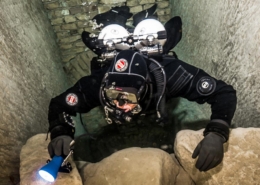Three Safety Protocols for Technical Diving
By Brian Shreve
Technical diving comes with risk. No getting around it. To manage this risk, technical divers, instructors and training agencies developed basic procedures. These are ones every tech diver should understand, recall and utilize.
What would technical diving be without acronyms? To help divers remember three safety protocols which are important on every dive, TDI established the acronyms START, MODS and STOP. Let’s look at these in a little more detail and begin with START.
START
This acronym helps divers remember to do a pre-dive safety check with their buddies. This encompasses everything a dive team should cover before beginning the dive.
Despite some recent internet buzz questioning the value of the pre-dive safety check, and poking fun at divers who do it, technical divers really should use some form of pre-dive check to make sure they have everything, everything functions as intended, backups are in place, and the team knows what the plan is. START provides a progression which helps dive teams do just that. It stands for:
- S-drills and bubble checks
- Team equipment matching
- Air (gas matching)
- Route (team order, direction, overall objective and dive waypoints)
- Tables (planned depth, time, gas switches)
Sometimes it makes sense to do these in a different order. For example, you may want to go through team equipment matching while at the vehicle (where all your stuff is) before making a long hike to the water only to discover you forgot your primary light or your fins.
Regardless of order, going through START before each dive only takes a few moments and makes sure the team is ready for the dive. How you complete each step is up to you and your team, but actually doing it is the important part.
MODS
Technical diving typically means carrying different gasses on the same dive. One of the biggest risks in technical diving comes during the gas switch. The easiest way to die on a technical dive is to breathe the wrong gas at the wrong depth.
A protocol for validating gas switches to manage this risk is crucial. MODS provides this. While some divers attempt to rely on color coding, different regulators and so forth to code gasses, these approaches aren’t fool-proof. You need a more detailed method to assure you and your teammates have switched to the intended gas. Let’s break it down:
- Mix – diver identifies the cylinder containing the correct mix, shows it to the team, and team validates it is the proper mix for the upcoming gas switch
- Open – diver opens the valve on the cylinder and deploys hose and second stage
- Depth – diver references depth and confirms they are at or above the mix’s MOD
- Switch – the diver switches to the deployed second stage to begin breathing the new mix, and switches their computer (if using one, and who doesn’t these days?) to the new mix
By using MODS, the dive team can easily manage the risk of being on the wrong gas, either below its MOD, or above a depth where it becomes hypoxic. With just a little practice, MODS can be employed effectively, adding no significant time to the gas switch.
STOP
At the conclusion of the planned bottom time or the beginning of the ascent to the first deco stop, we can use another acronym to guide us through a series of checks. This provides an opportunity for the team to verify readiness and organize the ascent. Many teams do this routinely without realizing it, but this step keeps the team together and organized. STOP stands for:
- Schedule – which depth/runtime schedule is the correct one to use?
- Team – is the team ready to finish the dive, and have all agreed on the schedule?
- Orientation – is everyone familiar with or can see the “exit” or ascent route?
- Proceed – begin the ascent at the proscribed rate according to the plan
By taking just a moment, and STOPping before your ascent, you and your team can avoid separation on the ascent, avoid missed deco stops by verifying the appropriate ascent schedule and ascend as a team. This is also important because it keeps the team together to facilitate the team gas switches discussed earlier.
While there are other approaches to these, learning, understanding and following the protocols outlined above will help you and your team to stay organized, manage risks and enjoy your dives. Using standardized protocols helps your team answer the questions, Am I and is my team ready – for the dive, for the gas switch, for the ascent and for fun?
Have a protocol you prefer? Add it to the comments below. We’d love to hear about it!










返信を残す
Want to join the discussion?Feel free to contribute!